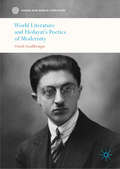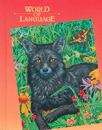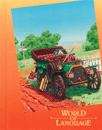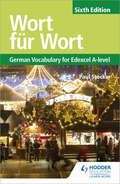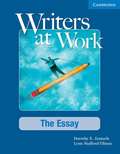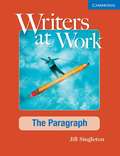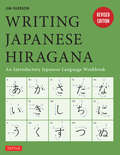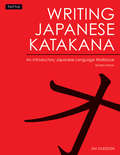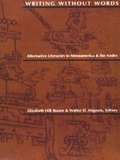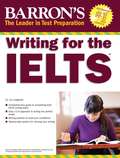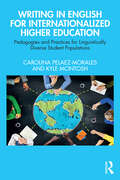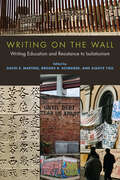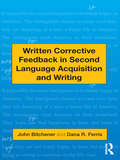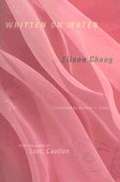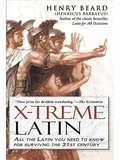- Table View
- List View
World Literature and Hedayat’s Poetics of Modernity (Canon and World Literature)
by Omid AzadibougarThis book introduces the canonical figure Sadegh Hedayat (1903–1951) and draws a comprehensive image of a major intellectual force in the context of both modern Persian Literature and World Literature. A prolific writer known for his magnum opus, The Blind Owl (1936), Hedayat established the use of common language for literary purposes, opened new horizons on imaginative literature and explored a variety of genres in his creative career. This book looks beyond the reductive critical tendencies that read a rich and diverse literary profile in light of Hedayat’s suicide, arguing instead that his literary imagination was not solely the result of genius but rather enriched by a vast network of the world’s literary traditions. This study reflects on Hedayat’s attempts at various genres of artistic creation, including painting, fiction writing, satire and scholarly research, as well as his persistent struggles for artistic authenticity, which transcended solidly established literary and artistic norms. Providing a critical reading of Hedayat’s work to untangle aspects of his writing – including reflections on science, religion, nationalism and coloniality – alongside his pioneering work on folk culture, and how humor informs his writings, this text offers a critical review of the status of Persian literature in the contemporary landscape of the world’s literary studies.
World Of Language
by Wendy Davis Sandra Breuer Judy BrimThe book that unlocks all imagination opening every mind to new and exciting ideas. World of language is a literature book that indeed enlarges your world to think, read, speak, listen and write.
World of Language
by Marian Davies Toth Betty G. Gray Nancy Nickell RagnoThis text contains unit lessons on Using Language to narrate; to inform; to imagine; to persuade; to describe; to research; to create; and to classify.
Worlding a Peripheral Literature (Canon and World Literature)
by Marko JuvanBringing together the analyses of the literary world-system, translation studies, and the research of European cultural nationalism, this book contests the view that texts can be attributed global importance irrespective of their origin, language, and position in the international book market. Focusing on Slovenian literature, almost unknown to world literature studies, this book addresses world literature’s canonical function in the nineteenth-century process of establishing European letters as national literatures. Aware of their dependence on imperial powers, (semi)peripheral national movements sought international recognition through, among other things, the newly invented figure of the national poet. Writers central to dependent national communities were canonized to represent their respective cultures to the norm-giving Other – the emerging world literary canon and its aesthetic ideology. Hence, national literatures asserted their linguo-cultural individuality through the process of worlding; that is, by their positioning in the international literary world informed by the supposed universality of the aesthetic.
Wort für Wort Sixth Edition: German Vocabulary for AQA A-level
by Paul StockerExam board: AQALevel: A-levelSubject: GeographyFirst teaching: September 2016First exams: Summer 2018Essential vocabulary for AQA A-level German, all in one place.- Supplement key resources such as course textbooks with all the vocab students need to know in one easy-to-navigate place, completed updated to match the latest specification - Ensure extensive vocab coverage with topic-by-topic lists of key words and phrases, including a new section dedicated to film and literature - Test students' knowledge with end-of-topic activities designed to deepen their understanding of word patterns and relationships - Develop effective strategies for learning new vocab and dealing with unfamiliar words
Wort für Wort Sixth Edition: German Vocabulary for AQA A-level
by Paul StockerExam board: AQALevel: A-levelSubject: GeographyFirst teaching: September 2016First exams: Summer 2018Essential vocabulary for AQA A-level German, all in one place.- Supplement key resources such as course textbooks with all the vocab students need to know in one easy-to-navigate place, completed updated to match the latest specification - Ensure extensive vocab coverage with topic-by-topic lists of key words and phrases, including a new section dedicated to film and literature - Test students' knowledge with end-of-topic activities designed to deepen their understanding of word patterns and relationships - Develop effective strategies for learning new vocab and dealing with unfamiliar words
Wort für Wort Sixth Edition: German Vocabulary for Edexcel A-level
by Paul StockerExam board: EdexcelLevel: A-levelSubject: GermanFirst teaching: September 2016First exams: Summer 2017Essential vocabulary for Edexcel A level German, all in one place.- Supplement key resources such as course textbooks with all the vocab students need to know in one easy-to-navigate place, completed updated to match the latest specification - Ensure extensive vocab coverage with topic-by-topic lists of key words and phrases, including a new section dedicated to film and literature - Test students' knowledge with end-of-topic activities designed to deepen their understanding of word patterns and relationships - Develop effective strategies for learning new vocab and dealing with unfamiliar words
Wort für Wort Sixth Edition: German Vocabulary for Edexcel A-level
by Paul StockerExam board: EdexcelLevel: A-levelSubject: GermanFirst teaching: September 2016First exams: Summer 2017Essential vocabulary for Edexcel A level German, all in one place.- Supplement key resources such as course textbooks with all the vocab students need to know in one easy-to-navigate place, completed updated to match the latest specification - Ensure extensive vocab coverage with topic-by-topic lists of key words and phrases, including a new section dedicated to film and literature - Test students' knowledge with end-of-topic activities designed to deepen their understanding of word patterns and relationships - Develop effective strategies for learning new vocab and dealing with unfamiliar words
Writers at Work: The Essay
by Dorothy E. Zemach Lynn Stafford-YilmazThe Writers at Work series takes beginning to high intermediate-level writing students through a process approach to writing. The series is intended primarily for adults whose first language is not English, but it may also prove effective for younger writers or for native speakers of English who are developing their competence as independent writers in English.
Writers at Work: The Paragraph
by Jill SingletonThe Writers at Work series prepares ESL students to tackle academic essay writing. Writers at Work: The Paragraph is designed for high-beginning to low-intermediate writing students. It uses personal topics such as "A Person Important to You" and "Holidays" to teach the basics of paragraph writing. A five-step process approach teaches students how to generate ideas, write a first draft, revise, edit, and self-evaluate their writing.
Writing Japanese Hiragana
by Jim GleesonThis guide presents exercises, review practices and lively illustrations, helping the reader to learn to write Hiragana.
Writing Japanese Hiragana
by Jim GleesonPut simply, practice is the most effective method of mastering written Japanese. The large, open format of Writing Japanese Hiragana invites the student to pick up a pencil and get started!Two phonetic syllabaries, hiragana and katakana, and a set of kanji characters based on Chinese ideographs are what comprises written Japanese. This workbook has been carefully designed to facilitate the quick and easy mastery of the forty-six character hiragana syllabary used to write all types of native words not written in kanji. An understanding of hiragana is essential for the serious student wishing to learn Japanese effectively.Each character is introduced with brushed, handwritten, and typed samples which enhance character recognition. Extensive writing space allows for maximum practice to facilitate memorization and ensure proper character formation. Entertaining illustrations and amusing examples of onomatopoeic usage of hiragana in Japanese writings further reinforce memorization in a fun way.Writing Japanese Hiragana is an easy-to-use and practical workbook tailored to the specific needs of young students of the Japanese language. Beginning students of all ages will delight in its fresh presentation.
Writing Japanese Hiragana
by Jim GleesonPut simply, practice is the most effective method of mastering written Japanese. The large, open format of Writing Japanese Hiragana invites the student to pick up a pencil and get started!Two phonetic syllabaries, hiragana and katakana, and a set of kanji characters based on Chinese ideographs are what comprises written Japanese. This workbook has been carefully designed to facilitate the quick and easy mastery of the forty-six character hiragana syllabary used to write all types of native words not written in kanji. An understanding of hiragana is essential for the serious student wishing to learn Japanese effectively.Each character is introduced with brushed, handwritten, and typed samples which enhance character recognition. Extensive writing space allows for maximum practice to facilitate memorization and ensure proper character formation. Entertaining illustrations and amusing examples of onomatopoeic usage of hiragana in Japanese writings further reinforce memorization in a fun way.Writing Japanese Hiragana is an easy-to-use and practical workbook tailored to the specific needs of young students of the Japanese language. Beginning students of all ages will delight in its fresh presentation.
Writing Japanese Katakana
by Jim GleesonThis is an introductory guide and workbook to writing Japanese Katakana.Anybody who is able to master English, with its irregular spellings and idiosyncratic pronunciations, is more than equipped to master written Japanese. The hiragana and katakana syllabaries are purely phonetic characters, which function much like the letters of the English alphabet. In this respect, kana are quite different from kanji characters, which are based on Chinese ideographs and which represent ideas. The katakana syllabary is used primarily to represent borrowed words (from languages other than Chinese), although it is also used for botanical names and is sometimes used in place of hiragana or kanji for emphasis. In some ways, the use of katakana in Japanese parallels the use of italics in English.Writing practice is the most effective method of mastering written Japanese, and the large open format of this workbook is designed to invite the student to pick up a pencil and start writing. Written Japanese comprises two phonetic syllabaries, hiragana and katakana, and a set of kanji characters that are based on Chinese ideographs. This workbook has been carefully designed to facilitate the quick and easy mastery of the 46-character katakana alphabet, making it the perfect tool to begin the process of mastering written Japanese. Each character is introduced with brushed, handwritten and typed samples that enhance character recognition. Extensive space for writing allows maximum practice to facilitate memorization and to ensure proper character formation. Entertaining illustrations and amusing examples of loan-words that use katakana in Japanese writings further reinforce memorization in a fun way. Writing Katakana is tailored to the specific needs of young students of the Japanese language, but is also well suited to beginning students of any age. This workbook contains:grayed-out, trace-over characters for correct character constructionExtensive practice in writing sentences for maximum reinforcementSupplementary explanations, including a brief history of the origin of each character, to foster visual recall.
Writing Japanese Katakana
by Jim GleesonThis is an introductory guide and workbook to writing Japanese Katakana.Anybody who is able to master English, with its irregular spellings and idiosyncratic pronunciations, is more than equipped to master written Japanese. The hiragana and katakana syllabaries are purely phonetic characters, which function much like the letters of the English alphabet. In this respect, kana are quite different from kanji characters, which are based on Chinese ideographs and which represent ideas. The katakana syllabary is used primarily to represent borrowed words (from languages other than Chinese), although it is also used for botanical names and is sometimes used in place of hiragana or kanji for emphasis. In some ways, the use of katakana in Japanese parallels the use of italics in English.Writing practice is the most effective method of mastering written Japanese, and the large open format of this workbook is designed to invite the student to pick up a pencil and start writing. Written Japanese comprises two phonetic syllabaries, hiragana and katakana, and a set of kanji characters that are based on Chinese ideographs. This workbook has been carefully designed to facilitate the quick and easy mastery of the 46-character katakana alphabet, making it the perfect tool to begin the process of mastering written Japanese. Each character is introduced with brushed, handwritten and typed samples that enhance character recognition. Extensive space for writing allows maximum practice to facilitate memorization and to ensure proper character formation. Entertaining illustrations and amusing examples of loan-words that use katakana in Japanese writings further reinforce memorization in a fun way. Writing Katakana is tailored to the specific needs of young students of the Japanese language, but is also well suited to beginning students of any age. This workbook contains:grayed-out, trace-over characters for correct character constructionExtensive practice in writing sentences for maximum reinforcementSupplementary explanations, including a brief history of the origin of each character, to foster visual recall.
Writing Japanese Katakana
by Jim GleesonThis is an introductory guide and workbook to writing Japanese Katakana.Anybody who is able to master English, with its irregular spellings and idiosyncratic pronunciations, is more than equipped to master written Japanese. The hiragana and katakana syllabaries are purely phonetic characters, which function much like the letters of the English alphabet. In this respect, kana are quite different from kanji characters, which are based on Chinese ideographs and which represent ideas. The katakana syllabary is used primarily to represent borrowed words (from languages other than Chinese), although it is also used for botanical names and is sometimes used in place of hiragana or kanji for emphasis. In some ways, the use of katakana in Japanese parallels the use of italics in English.Writing practice is the most effective method of mastering written Japanese, and the large open format of this workbook is designed to invite the student to pick up a pencil and start writing. Written Japanese comprises two phonetic syllabaries, hiragana and katakana, and a set of kanji characters that are based on Chinese ideographs. This workbook has been carefully designed to facilitate the quick and easy mastery of the 46-character katakana alphabet, making it the perfect tool to begin the process of mastering written Japanese. Each character is introduced with brushed, handwritten and typed samples that enhance character recognition. Extensive space for writing allows maximum practice to facilitate memorization and to ensure proper character formation. Entertaining illustrations and amusing examples of loan-words that use katakana in Japanese writings further reinforce memorization in a fun way. Writing Katakana is tailored to the specific needs of young students of the Japanese language, but is also well suited to beginning students of any age. This workbook contains: grayed-out, trace-over characters for correct character construction. Extensive practice in writing sentences for maximum reinforcement. Supplementary explanations, including a brief history of the origin of each character, to foster visual recall.
Writing Without Words: Alternative Literacies in Mesoamerica and the Andes
by Walter D. Mignolo Elizabeth Hill BooneThe history of writing, or so the standard story goes, is an ascending process, evolving toward the alphabet and finally culminating in the "full writing" of recorded speech. Writing without Words challenges this orthodoxy, and with it widespread notions of literacy and dominant views of art and literature, history and geography. Asking how knowledge was encoded and preserved in Pre-Columbian and early colonial Mesoamerican cultures, the authors focus on systems of writing that did not strive to represent speech. Their work reveals the complicity of ideology in the history of literacy, and offers new insight into the history of writing.The contributors--who include art historians, anthropologists, and literary theorists--examine the ways in which ancient Mesoamerican and Andean peoples conveyed meaning through hieroglyphic, pictorial, and coded systems, systems inseparable from the ideologies they were developed to serve. We see, then, how these systems changed with the European invasion, and how uniquely colonial writing systems came to embody the post-conquest American ideologies. The authors also explore the role of these early systems in religious discourse and their relation to later colonial writing.Bringing the insights from Mesoamerica and the Andes to bear on a fundamental exchange among art history, literary theory, semiotics, and anthropology, the volume reveals the power contained in the medium of writing.Contributors. Elizabeth Hill Boone, Tom Cummins, Stephen Houston, Mark B. King, Dana Leibsohn, Walter D. Mignolo, John Monaghan, John M. D. Pohl, Joanne Rappaport, Peter van der Loo
Writing for the IELTS
by Lin LougheedDiscover everything you’ll need to know in order to write well for the IELTS test, whether you are planning to take the Academic or the General Training version. This book will help IELTS test takers learn several essential skills, including:Task Achievement: follow a three-step model to plan, write, and revise your essaysCoherence and Cohesion: practice organizing your writing and connecting ideasLexical Resource: build your vocabulary and use it correctlyGrammatical Range and Accuracy: review rules and practice applying them to your writingEach section leads you step-by-step through the process of writing an essay in response to a particular task. Learn how to apply what you’ve learned, familiarize yourself with the types of questions you’ll have to respond to on the test, complete your responses within the time limits, and more. An Appendix also includes a More Writing Practice section with a selection of essays written in response to IELTS writing tasks.
Writing in English for Internationalized Higher Education: Pedagogies and Practices for Linguistically Diverse Student Populations
by Kyle McIntosh Carolina Pelaez-MoralesThis book is a user-friendly resource designed to help teachers meet the needs of linguistically, culturally, geographically, and educationally diverse students in the contemporary college composition classroom. Pelaez-Morales and McIntosh acknowledge that writing must be understood in context and address practical ways to support all writers of English, regardless of background. Chapters cover rhetorical strategies, genre analysis, feedback, and assessment. Drawing from a number of theoretical frameworks including intercultural rhetoric, L2 writing, translingualism, and World Englishes, the book’s practical, classroom-based suggestions will prepare pre- and in-service teachers to work in internationalized higher education contexts and to accommodate a range of knowledge and skill levels.
Writing on the Wall: Writing Education and Resistance to Isolationism
by David S. Martins Xiaoye You Brooke R. SchreiberThe first concerted effort of writing studies scholars to interrogate isolationism in the United States, Writing on the Wall reveals how writing teachers—often working directly with students who are immigrants, undocumented, first-generation, international, and students of color—embody ideas that counter isolationism. The collection extends existing scholarship and research about the ways racist and colonial rhetorics impact writing education; the impact of translingual, transnational, and cosmopolitan ideologies on student learning and student writing; and the role international educational partnerships play in pushing back against isolationist ideologies. Established and early-career scholars who work in a broad range of institutional contexts highlight the historical connections among monolingualism, racism, and white nationalism and introduce community- and classroom-based practices that writing teachers use to resist isolationist beliefs and tendencies. “Writing on the wall” serves as a metaphor for the creative, direct action writing education can provide and invokes border spaces as sites of identity expression, belonging, and resistance. The book connects transnational writing education with the fight for racial justice in the US and around the world and will be of significance to secondary and postsecondary writing teachers and graduate students in English, linguistics, composition, and literacy studies. Contributors: Olga Aksakalova, Sara P. Alvarez, Brody Bluemel, Tuli Chatterji, Keith Gilyard, Joleen Hanson, Florianne Jimenez Perzan, Rebecca Lorimer Leonard, Layli Maria Miron, Tony D. Scott, Kate Vieira, Amy J. Wan
Written Corrective Feedback in Second Language Acquisition and Writing
by John Bitchener Dana R. FerrisWhat should language and writing teachers do about giving students written corrective feedback? This book surveys theory, research, and practice on the important and sometimes controversial issue of written corrective feedback, also known as “error/grammar correction,” and its impact on second language acquisition and second language writing development. Offering state-of-the-art treatment of a topic that is highly relevant to both researchers and practitioners, it critically analyzes and synthesizes several parallel and complementary strands of research — work on error/feedback (both oral and written) in SLA and studies of the impact of error correction in writing/composition courses — and addresses practical applications. Drawing from both second language acquisition and writing/composition literature, this volume is the first to intentionally connect these two separate but important lines of inquiry.
Written on Water
by Eileen Chang Andrew Jones Ailing Zhang Nicole HuangKnown as "the Garbo of Chinese letters" for her elegance and the aura of mystery that surrounded her, Eileen Chang is regarded as one of the greatest and most influential modern Chinese novelists and cultural critics of the twentieth century. In Written on Water, first published in 1945 and now available for the first time in English, Chang offers essays on art, literature, war, and urban life, as well as autobiographical reflections. Chang takes in the sights and sounds of wartime Shanghai and Hong Kong, with the tremors of national upheaval and the drone of warplanes in the background, and inventively fuses explorations of urban life, literary trends, domestic habits, and historic events. These evocative and moving firsthand accounts examine the subtle and not-so-subtle effects of the Japanese bombing and occupation of Shanghai and Hong Kong. Eileen Chang writes of friends, colleagues, and teachers turned soldiers or wartime volunteers, and her own experiences as a part-time nurse. Her nuanced depictions range from observations of how a woman's elegant dress affects morale to descriptions of hospital life. With a distinctive style that is at once meditative, vibrant, and humorous, Chang engages the reader through sly, ironic humor; an occasionally chatty tone; and an intense fascination with the subtleties of modern urban life. The collection vividly captures the sights and sounds of Shanghai, a city defined by its mix of tradition and modernity. Chang explores the city's food, fashions, shops, cultural life, and social mores; she reveals and upends prevalent attitudes toward women and in the process presents a portrait of a liberated, cosmopolitan woman, enjoying the opportunities, freedoms, and pleasures offered by urban life. In addition to her descriptions of daily life, Chang also reflects on a variety of artistic and literary issues, including contemporary films, the aims of the writer, the popularity of the Peking Opera, dance, and painting.
X-Treme Latin
by Henry BeardIn staff meetings and singles bars, on freeways and fairways, there are aggravating people lurking everywhere these days. But bestselling humorist Henry Beard has the perfect comeback for all prickly situations, offering a slew of quips your nemesis won't soon forget . . . or even understand. Beard's gift is his ability to make fun of popular culture and the current zeitgeist. In X-Treme Latin he provides Latin with an attitude, an indispensable phrasebook that taps the secret power of Latin to deliver, in total safety, hundreds of impeccable put-downs, comebacks, and wisecracks. Within its pages you will learn how to insult or fire coworkers; blame corporate scandals on someone else; cheer at a World Wrestling Entertainment match; talk back to your computer, TV, or Game Boy; deal with your road rage; evade threatening situations; snowboard in style; talk like Tony Soprano; and much more. With dozens more zingers for quashing e-mail pranks, psyching out your golf opponent, giving backhanded compliments, and evading awkward questions, X-Treme Latin is destined for magnus popularity and will have readers cheering, "Celebremus!"
X-Treme Latin: Lingua Latina Extrema
by Henry BeardEverything you'll need to say in Latin for hipsters, party animals, slackers, pop-culture junkies, the corporately downsized and generally disaffected
